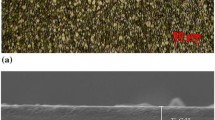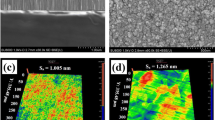Abstract
The lack of resistance to wear of the biomaterials and release of ions cause implant loosening, which leads to implant failure. As a result, surface modification of such biomaterials (316L SS) is required to ensure implant durability. To improve the wear resistance and durability of the implant, the Ta layer was deposited on 316L SS, and film quality can be enhanced by having excellent control of parameters during deposition. Metallic coating (Tantalum) was applied on the surface of stainless steel type 316L by DC magnetron sputtering, followed by wear behavior and microhardness investigations. Wear studies through pin-on-disk tribometer are used to evaluate tribological properties, i.e., wear rate and friction coefficient behavior following ASTM G99-95a and ASTM G133-95. Wear tests were conducted in simulated body fluid under various normal applied load conditions (10 N, 20 N, and 40 N) and a sliding distance of 10 m. Based on wear test results, the wear rate (\(62.50\times {10}^{-5}{\mathrm{mm}}^{3}/\mathrm{Nm}\)) was found to be very high for bare 316L SS at an applied load of 40 N, and the wear rate \((3.75\times {10}^{-5}{\mathrm{mm}}^{3}/\mathrm{Nm})\) was found to be low for Ta-coated (60 min.) 316L SS at the same load. Wear-resistant and surface hardness of Ta-coated 316L SS were found to increase with an increase in the thickness of the coating. Ta-coated was found to be a higher hardness and lower modulus of elasticity against bare 316L SS. Optical microscopy, scanning electron microscopy, energy-dispersive X-ray analysis, and atomic force microscopy were used to characterize the surface morphology of worn bare and Ta-coated 316L SS. This study aims to see how Ta-based coatings could be used to improve the surface morphology of austenitic stainless steel.
Graphical abstract










Similar content being viewed by others
Abbreviations
- ASTM:
-
American Society for Testing and Materials
- 316L SS:
-
Low carbon stainless steel type 316
- DC:
-
Direct current
- MFC:
-
Mass flow controller
- Ta:
-
Tantalum
- CNC:
-
Computer numerical controller
- EDM:
-
Electrical discharge machining
- SCCM:
-
Standard cubic centimeters per minute
- DCMS:
-
Direct current magnetron sputtering system
- DOE:
-
Design of experiment
- SEM:
-
Scanning electron microscopy
- EDS:
-
Energy-dispersive X-ray spectroscopy
- AFM:
-
Atomic force microscopy
- SPM:
-
Scanning probe microscopy
- WEDM:
-
Wire electrical discharge machining
- PVD:
-
Physical vapor deposition
- COF:
-
Coefficient of friction
- min:
-
Minute
- THA:
-
Total hip arthroplasty
- K2HPO4.6H2O:
-
Di-potassium hydrogen phosphate hexa-hydrate
- (CH2OH)3 :
-
CNH2- Tris (Hydroxymethyl) amino methane
- R a :
-
Average roughness
- R q :
-
Root mean square roughness
- \(\overline{z}\) :
-
Arithmetic average height
References
Geringer J, Tatkiewicz W, Rouchouse G (2011) Wear behavior of PAEK, poly(aryl-ether-ketone), under physiological conditions, outlooks for performing these materials in the field of hip prosthesis. Wear 271(11–12):2793–2803. https://doi.org/10.1016/j.wear.2011.05.034
Dincel Ö, Şimşek İ, Özyürek D (2021) Investigation of the wear behavior in simulated body fluid of 316L stainless steels produced by mechanical alloying method. Eng Sci Technol Int J 24(1):35–40. https://doi.org/10.1016/j.jestch.2020.12.001
Navarro CH, Martínez MF, Carvajal EEC, Reséndiz LPR, Bustos EDG (2021) Analysis of the wear behavior of multilayer coatings of TaZrN/TaZr produced by magnetron sputtering on AISI-316L stainless steel. Int J Adv Manuf Technol 117(5–6):1565–1573. https://doi.org/10.1007/s00170-021-07655-6
Jourani A, Bouvier S (2015) Friction and wear mechanisms of 316L stainless steel in dry sliding contact: effect of abrasive particle size. Tribol Trans 58(1):131–139. https://doi.org/10.1080/10402004.2014.955229
Li HF, Huang JY, Lin GC, Wang PY (2021) Recent advances in tribological and wear properties of biomedical metallic materials. Rare Met 40(11):3091–3106. https://doi.org/10.1007/s12598-021-01796-z
Uwais ZA, Hussein MA, Samad MA, Al-Aqeeli N (2017) Surface modification of metallic biomaterials for better tribological properties: a review. Arab J Sci Eng 42(11):4493–4512. https://doi.org/10.1007/s13369-017-2624-x
Jaiswal D, Singh V, Pathote D, Behera CK (2021) Electrochemical behaviour of lead-free Sn–0.7Cu–xIn solders alloys in 3.5 wt% NaCl solution. J Mater Sci Mater Electron 32(18):23371–23384. https://doi.org/10.1007/s10854-021-06824-3
Pathote D, Jaiswal D, Singh V, Behera CK (2022) Optimization of electrochemical corrosion behavior of 316L stainless steel as an effective biomaterial for orthopedic applications. Mater Today Proc 57:265–269. https://doi.org/10.1016/J.MATPR.2022.02.501
Weeden SH, Schmidt RH (2007) The use of tantalum porous metal implants for Paprosky 3A and 3B defects. J Arthroplasty 22(6 SUPPL.):151–155. https://doi.org/10.1016/j.arth.2007.04.024
Rosen C (2011) Principles and practices. 52(204). doi:https://doi.org/10.46692/9781447343264.004
Benz K et al (2012) Rheological and biological properties of a hydrogel support for cells intended for intervertebral disc repair. BMC Musculoskelet Disord 13:1–13. https://doi.org/10.1186/1471-2474-13-54
Bonitatibus PJ, Torres AS, Goddard GD, Fitzgerald PF, Kulkarni AM (2010) Synthesis, characterization, and computed tomography imaging of a tantalum oxide nanoparticle imaging agent. Chem Commun 46(47):8956–8958. https://doi.org/10.1039/c0cc03302b
Janowski M, Bulte JWM, Walczak P (2012) Personalized nanomedicine advancements for stem cell tracking. Adv Drug Deliv Rev 64(13):1488–1507. https://doi.org/10.1016/j.addr.2012.07.008
Kumar S, Jaiswal D, Behera CK, Mahobia GS (2022) Potentiodyanmic corrosion behavior of Fe–18Cr–21Mn-0. 65 N austenitic stainless steel exposed at 400–700 °C. Mater Chem Phys, 290(May): 126568. doi:https://doi.org/10.1016/j.matchemphys.2022.126568
Frigg A, Dougall H, Boyd S, Nigg B (2010) Can porous tantalum be used to achieve ankle and subtalar arthrodesis?: A pilot study. Clin Orthop Relat Res 468(1):209–216. https://doi.org/10.1007/s11999-009-0948-x
Ma J, Sun W, Gao F, Guo W, Wang Y, Li Z (2016) Porous tantalum implant in treating osteonecrosis of the femoral head: still a viable option? Sci Rep 6:1–10. https://doi.org/10.1038/srep28227
Singh V, Jaiswal D, Pathote D, Behera CK (2022) Drop calorimetric measurement of In-Zn system for Lead-Free solder applications. Mater Today Proc 57:285–288. https://doi.org/10.1016/j.matpr.2022.02.601
Jaiswal D, Pathote D, Singh V, Behera CK (2022) Electrochemical behaviour of lead-free Sn–In–Al solders alloys in 3.5 wt.% NaCl solution. Mater Today Proc. doi:https://doi.org/10.1016/j.matpr.2022.02.315
Zhang Y, Ahn PB, Fitzpatrick DC, Heiner AD, Poggie RA, Brown TD (1999) Interfacial frictional behavior: cancellous bone, cortical bone, and a novel porous tantalum biomaterial. J Musculoskelet Res 3(4):245–251. https://doi.org/10.1142/S0218957799000269
Shirazi-Adl A, Dammak M, Paiement G (1993) Experimental determination of friction characteristics at the trabecular bone/porous-coated metal interface in cementless implants. J Biomed Mater Res 27(2):167–175. https://doi.org/10.1002/jbm.820270205
Sagomonyants KB, Hakim-Zargar M, Jhaveri A, Aronow MS, Gronowicz G (2011) Porous tantalum stimulates the proliferation and osteogenesis of osteoblasts from elderly female patients. J Orthop Res 29(4):609–616. https://doi.org/10.1002/jor.21251
White CJ, Ramee SR, Banks AK, Mesa JE, Chokshi S, Isner JM (1992) A new balloon-expandable tantalum coil stent: angiographic patency and histologic findings in an atherogenic swine model. J Am Coll Cardiol 19(4):870–876. https://doi.org/10.1016/0735-1097(92)90534-T
Jaiswal D, Pathote D, Singh V, Behera CK (2022) Effect of Al addition on electrochemical behavior of Sn-0.7Cu-xAl lead-free solders alloys in 3.5 wt.% NaCl solution. J Mater Eng Perform. doi:https://doi.org/10.1007/s11665-022-06771-y
dos Santos GA (2017) The importance of metallic materials as biomaterials. Adv Tissue Eng Regen Med Open Access 3(1):300–302. https://doi.org/10.15406/atroa.2017.03.00054
Rai VK, Kumar MR, Singh V, Jaiswal D, Behera CK (2019) Analysis of corrosion behavior and its characterization of In–Sn–Bi alloy. Mater Today Proc 18:2322–2328. https://doi.org/10.1016/j.matpr.2019.07.015
Kumar MR, Singh V, Rai VK, Jaiswal D, Behera CK (2019) Investigation on mixing heat effect of Bi–In and In–Sn system at 730 K. Mater Today Proc 18:2917–2923. https://doi.org/10.1016/j.matpr.2019.07.161
Rai PK et al (2017) Wear behavior of harmonic structured 304L stainless steel. J Mater Eng Perform 26(6):2608–2618. https://doi.org/10.1007/s11665-017-2719-2
Raposo M, Ferreira Q, Ribeiro PA (2007) A guide for atomic force microscopy analysis of soft-condensed matter. Mod Res Educ Top Microsc, pp 758–769. doi:https://doi.org/10.1002/sia.2294
Wang R et al (2019) Using atomic force microscopy to measure thickness of passive film on stainless steel immersed in aqueous solution. Sci Rep 9(1):1–11. https://doi.org/10.1038/s41598-019-49747-0
Geringer J, Pellier J, Cleymand F, Forest B (2012) Atomic force microscopy investigations on pits and debris related to fretting-corrosion between 316L SS and PMMA. Wear 292–293:207–217. https://doi.org/10.1016/j.wear.2012.05.008
Wang XY, Wu YS, Zhang L, Yu ZY (2001) Atomic force microscopy and x-ray photoelectron spectroscopy study on the passive film for type 316L stainless steel. Corrosion 57(6):540–546. https://doi.org/10.5006/1.3290380
Li X, Wang X, Bondokov R, Morris J, An YH, Sudarshan TS (2005) Micro/nanoscale mechanical and tribological characterization of SiC for orthopedic applications. J Biomed Mater Res Part B Appl Biomater 72(2):353–361. https://doi.org/10.1002/jbm.b.30168
Attabi S, Himour A, Laouar L, Motallebzadeh A (2021) Mechanical and wear behaviors of 316L stainless steel after ball burnishing treatment. J Mater Res Technol 15:3255–3267. https://doi.org/10.1016/j.jmrt.2021.09.081
Gao X-W, Davies T, Beskos D (2003) Boundary element programming in mechanics. Appl Mech Rev 56(1):B1–B1. https://doi.org/10.1115/1.1523350
Eliaz N (2019) Corrosion of metallic biomaterials: a review. Materials (Basel), 12(3). doi:https://doi.org/10.3390/ma12030407
Jenczyk P, Gawrońska M, Dera W, Chrzanowska-Giżyńska J, Denis P, Jarząbek DM (2019) Application of SiC particles coated with a protective Ni layer for production of Ni/SiC co-electrodeposited composite coatings with enhanced tribological properties. Ceram Int 45(17):23540–23547. https://doi.org/10.1016/j.ceramint.2019.08.063
Liu LL, Xu J, Lu X, Munroe P, Xie ZH (2016) Electrochemical corrosion behavior of nanocrystalline β-Ta coating for biomedical applications. ACS Biomater Sci Eng 2(4):579–594. https://doi.org/10.1021/acsbiomaterials.5b00552
Gao J, et al (2022) Wear, corrosion, and biocompatibility of 316L stainless steel modified by well-adhered Ta coatings. J Mater Eng Perform, no. Ref 15. doi:https://doi.org/10.1007/s11665-022-06928-9
Sikdar K, Shekhar S, Balani K (2014) Fretting wear of Mg–Li–Al based alloys. Wear 318(1–2):177–187. https://doi.org/10.1016/j.wear.2014.06.012
Fellah M, Labaïz M, Assala O, Lost A, Dekhil L (2013) Tribological behaviour of AISI 316L stainless steel for biomedical applications. Tribol - Mater Surfaces Interfaces 7(3):135–149. https://doi.org/10.1179/1751584X13Y.0000000032
García-León RA, Martínez-Trinidad J, Campos-Silva I, Figueroa-López U, Guevara-Morales A (2021) Wear maps of borided AISI 316L steel under ball-on-flat dry sliding conditions. Mater Lett 282:17–18. https://doi.org/10.1016/j.matlet.2020.128842
Cohen J (1967) Biomaterials in orthopedic surgery. Am J Surg 114(1):31–41. https://doi.org/10.1016/0002-9610(67)90037-2
Du S et al (2018) Optimizing the tribological behavior of tantalum carbide coating for the bearing in total hip joint replacement. Vacuum 150:222–231. https://doi.org/10.1016/j.vacuum.2018.01.050
Zhang TF et al (2015) Wear and corrosion properties of diamond like carbon (DLC) coating on stainless steel, CoCrMo and Ti6Al4V substrates. Surf Coatings Technol 273(1):12–19. https://doi.org/10.1016/j.surfcoat.2015.03.031
Acknowledgements
The authors gratefully acknowledge the funding from the Science and Engineering Research Board (SERB) of India (Project No. R&D/SERB/MET/19-20/04) and for the research experimental facilities of the "Indian Institute of Technology Banaras Hindu University" (IIT-BHU), Varanasi-221005 India.
Author information
Authors and Affiliations
Corresponding author
Ethics declarations
Conflict of interest
The authors declared that they have no conflict of interest.
Additional information
Handling Editor: Yaroslava Yingling.
Publisher's Note
Springer Nature remains neutral with regard to jurisdictional claims in published maps and institutional affiliations.
Supplementary Information
Below is the link to the electronic supplementary material.
Rights and permissions
Springer Nature or its licensor (e.g. a society or other partner) holds exclusive rights to this article under a publishing agreement with the author(s) or other rightsholder(s); author self-archiving of the accepted manuscript version of this article is solely governed by the terms of such publishing agreement and applicable law.
About this article
Cite this article
Pathote, D., Jaiswal, D., Singh, V. et al. Wear behavior and microhardness studies of tantalum (Ta)-coated 316L stainless steel by DC magnetron sputtering for the orthopedic applications. J Mater Sci 57, 21039–21056 (2022). https://doi.org/10.1007/s10853-022-07939-6
Received:
Accepted:
Published:
Issue Date:
DOI: https://doi.org/10.1007/s10853-022-07939-6




